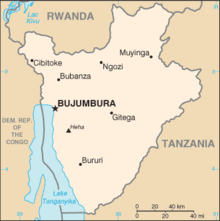1987 Burundian coup d'état
 | |
| Date | 3 September 1987 |
|---|---|
| Location | Bujumbura, Burundi |
| Type | Military coup |
| Motive | Regime change |
| Target | Presidential Palace, Bujumbura |
| Organised by | Pierre Buyoya |
| Outcome | Coup succeeds
|
| History of Burundi |
|---|
 |
The 1987 Burundian coup d'état was a bloodless military coup that took place in Burundi on 3 September 1987. Tutsi president Jean-Baptiste Bagaza was deposed whilst traveling abroad and succeeded by Tutsi Major Pierre Buyoya.[1][2]
Background
Jean-Baptiste Bagaza was appointed president of Burundi following a military coup in 1976, that deposed Michel Micombero. As president of the Union for National Progress (UPRONA) party, he was the sole candidate in the 1984 presidential election and was re-elected with 99.6% of the votes.[3] During Bagaza's presidency, there were long-standing tensions over the repression of the Roman Catholic Church, in a country where 65% of citizens are practising Catholics.[4] This was later described by diplomats as a key factor in the coup.[5]
Coup and aftermath
In September 1987, Bagaza travelled to Quebec, Canada, to attend a francophone summit.[2] The army took over, led by Bagaza's cousin, Major Pierre Buyoya.[6] Hearing of the coup, Bagaza immediately returned to Africa but Bujumbura Airport was closed, and in Nairobi, he was refused entrance to Kenya.[5] Following the coup, Bagaza fled to Uganda, and then in 1989, Libya, where he was granted political asylum.[7]
Buyoya formed the Military Committee for National Salvation to take control, suspended the country's constitution and was inaugurated as president on 2 October 1987.[3] Buyoya, a Roman Catholic, said that he would lift measures imposed on the Catholic Church by Bagaza's government.[8] He was succeeded by Melchior Ndadaye following the 1993 presidential election, and came to power in Burundi for a second time following a military coup in 1996, that ousted Sylvestre Ntibantunganya.[9]
References
- ^ Sheila Rule (1987-09-04). "Burundi's President Is Ousted by Army". The New York Times. Retrieved 19 January 2021.
- ^ a b Kieh, George Klay (2007). Beyond State Failure and Collapse: Making the State Relevant in Africa. Lexington Books. p. 73. ISBN 978-0-7391-0892-5.
- ^ a b Europa World Year, Book 1. Taylor & Francis. 2004. p. 946. ISBN 1-85743-254-1.
- ^ Rule, Sheila (24 September 2010), "Burundi Leader Attempts East-West Balance", The New York Times, The New York Times Company, retrieved 8 June 2010
- ^ a b Harden, Blaine (5 September 1987), "Dismay at Anti-Catholic Measures Said to Have Inspired Burundi Coup", The Washington Post, The Washington Post Company, archived from the original on 4 November 2012, retrieved 8 June 2010
- ^ Europa Publications (2004). Africa South of the Sahara 2004. Routledge. p. 135. ISBN 1-85743-183-9.
- ^ "Burundi's Ex-President Granted Asylum in Libya", Spartanburg Herald-Journal, The New York Times Company, 17 January 1989, retrieved 8 June 2010
- ^ Rule, Sheila (27 September 1987), "New Burundi Leader Vows to Lift Curbs on Church", The New York Times, The New York Times Company, retrieved 8 June 2010
- ^ Palmer, Mark (2005). Breaking the Real Axis of Evil: How to Oust the World's Last Dictators by 2025. Rowman & Littlefield. p. 221. ISBN 0-7425-3255-0.
